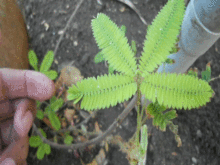Rapid plant movement

Rapid plant movement encompasses movement in plant structures occurring over a very short period, usually under one second. For example, the Venus flytrap closes its trap in about 100 milliseconds.[1] The dogwood bunchberry's flower opens its petals and fires pollen in less than 0.5 milliseconds. The record is currently held by the white mulberry tree, with flower movement taking 25 microseconds, as pollen is catapulted from the stamens at velocities in excess of half the speed of sound—near the theoretical physical limits for movements in plants.[2]
These rapid plant movements differ from the more common, but there are much slower "growth-movements" of plants, called tropisms.
Charles Darwin in 1880 published his last work before his death, The Power of Movement in Plants.
Plants that capture and consume prey
- Venus flytrap (Dionaea muscipula)
- Waterwheel plant (Aldrovanda vesiculosa)
- Bladderwort (Utricularia)
- Certain varieties of sundew (Drosera)
Plants that move leaves for other reasons

- Sensitive plant (Mimosa pudica)
- Catclaw brier (Mimosa nuttallii)
- Telegraph plant (Codariocalyx motorius)
- Partridge pea (Chamaecrista fasciculata)
- Sensitive partridge pea (Chamaecrista nictitans)
- Roemer sensitive briar (Schrankia roemeriana)
- Yellow neptunia (Neptunia lutea)
Plants that spread seeds or pollen by rapid movement
- Squirting cucumber (Ecballium agreste)
- Cardamine hirsuta and other Cardamine spp. have seed pods which explode when touched.
- Impatiens (Impatiens)
- Sandbox tree
- Triggerplant (all Stylidium species)
- Canadian dwarf cornel (aka dogwood bunchberry, Cornus canadensis)
- White mulberry (Morus alba)[2]
- Orchid (all Catasetum genus)
- Dwarf mistletoe (Arceuthobium)
- Witch-hazel (Hamamelis)
- Some Fabaceae have beans that twist as they dry out, putting tension on the seam, which at some point will split suddenly and violently, spraying the seeds metres from the maternal plant.[3][4]
- Marantaceae[5]
- Minnieroot (Ruellia tuberosa)
See also
References
- ↑ Forterre, Y., J.M. Skotheim, J. Dumais & L. Mahadevan 2005. "How the Venus flytrap snaps." (PDF). (318 KB) Nature 433: 421–425. doi:10.1038/nature03185
- 1 2 Taylor, P.E., G. Card, J. House, M. H. Dickinson & R.C. Flagan 2006. High-speed pollen release in the white mulberry tree, Morus alba L.. Sexual Plant Reproduction 19(1): 19–24. doi:10.1007/s00497-005-0018-9
- ↑ Tony D. Auld (1996). "Ecology of the Fabaceae in the Sydney region: fire, ants and the soil seedbank" (PDF). Cunninghamia. 4 (4): 531–551.
- ↑ Matt Lavin (2001). "Fabaceae". Macmillan Reference USA.
- ↑ "Marantaceae in Flora of North America @". Efloras.org. Retrieved 2011-07-18.